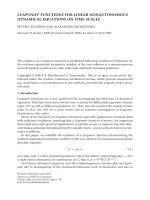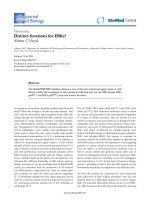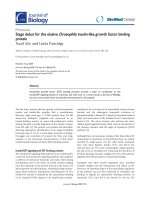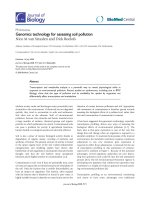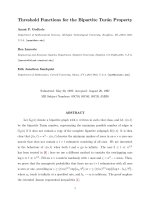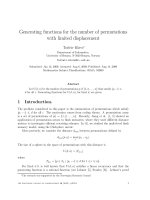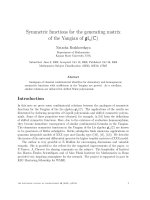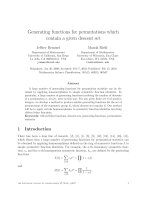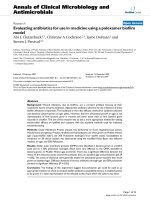Báo cáo sinh học: "Distinct functions for ERKs" docx
Bạn đang xem bản rút gọn của tài liệu. Xem và tải ngay bản đầy đủ của tài liệu tại đây (74.57 KB, 4 trang )
Minireview
Distinct functions for ERKs?
Alison C Lloyd
Address: MRC Laboratory for Molecular Cell Biology and Department of Biochemistry, University College London, Gower Street, London
WC1E 6BT, UK. Email:
An important intracellular signaling module leads from the
small GTPase Ras through a cascade of protein kinases - Raf,
MEK, and the extracellular signal regulated kinase ERK. Sig-
naling through the Ras/Raf/MEK/ERK pathway has been
implicated in many cellular processes, including prolifer-
ation, differentiation, survival, metabolism and morphol-
ogy. Deregulation of the pathway has been associated with
various pathologies, most notably with proliferative dis-
orders such as cancer but also, more recently, with specific
developmental abnormalities [1,2]. It is becoming increas-
ingly clear that the temporal regulation of this pathway is
critical for determining the signal output. A well known
example of this is seen in pheochromocytoma-derived PC12
cells, in which a transient activation of the pathway is associ-
ated with proliferation, whereas sustained activation drives
differentiation into neuronal-like cells [3]. Further evidence,
from a detailed study of Drosophila eye development, has
indicated that different thresholds of ERK activity result in
distinct outcomes in vivo; low and high levels of Ras/Raf/ERK
activity are associated with the promotion of cell survival
and differentiation, respectively [4]. There are many other
such examples in other cell types and diverse organisms
[5-7]. Preliminary insights into how signal dynamics can be
‘read’ by a cell have started to become apparent, but much is
not understood, and this remains one of the challenges of
cell biology [8,9].
The two ERKs, ERK1 (also called p44
ERK1
) and ERK2 (also
called p42
ERK2
), have numerous substrates, many of which
are nuclear and participate in the transcriptional regulation
of a range of cellular processes. The two kinases are very
similar in sequence and have tended to be thought of inter-
changeably [10]. The activity of the pathway is often repre-
sented by the levels of MEK-directed phosphorylation of
ERK1 and ERK2, as detected by phospho-specific anti-
bodies; the double bands on electrophoresis gels (phospho-
ERK1 and phospho-ERK2) that appear in response to
numerous stimuli are usually taken together as representing
total ERK activity. Likewise, the importance of this signaling
pathway in various cellular processes tends to be deduced
from the effects of well-characterized inhibitors such as
U0126, which inhibit the upstream kinase MEK and so
would not distinguish between the activity of the two ERKs.
Recent studies, however, including a report by Vantaggiato
and Formentini et al. [11] in this issue of Journal of Biology,
present compelling evidence that the ERK kinases are not
functionally redundant but might have very different roles.
The two ERK proteins are coexpressed in most tissues but
stark differences in their relative abundance were the first
possible hints of a differential function [12]. More intrigu-
ingly, the knockout phenotypes turned out to be very differ-
ent: ERK2 knockout mice die early in development, showing
Abstract
The Ras/Raf/MEK/ERK signaling pathway is one of the best understood signal routes in cells.
Recent studies add complexity to this cascade by indicating that the two ERK kinases, ERK1
(p44
ERK1
) and ERK2 (p42
ERK2
), may have distinct functions.
BioMed Central
Journal
of Biolo
gy
Journal of Biology 2006, 5:13
Published: 19 July 2006
Journal of Biology 2006, 5:13
The electronic version of this article is the complete one and can be
found online at />© 2006 BioMed Central Ltd
that ERK1 cannot compensate for ERK2 [13]. By contrast,
ERK1-deficient mice are viable, and have only minor defects,
such as a deficit in thymocyte maturation - and there is no
detectable compensatory upregulation of ERK2 levels [14].
The current study from Riccardo Brambilla’s laboratory [11]
along with a previous study from the same group [15]
provide the most convincing evidence to date that the two
kinases might have distinct roles. In these reports, an impor-
tant finding has been that loss of ERK1 can result in a mouse
with apparently ‘improved’ functions. ERK1
-/-
mice were
found to have an increased rate of learning and better long-
term memory than wild-type controls - processes in which
ERK signaling has previously been shown to be important
[15]. ERK2 levels were not higher in the brains of these
animals, but in primary neurons isolated from the knock-out
animals, enhanced ERK2 activation was observed, despite an
equivalent activation of the upstream kinase MEK. Further-
more, an enhancement of long-term potentiation was
observed in brain slices isolated from the ERK1
-/-
animals -
an improvement in function apparently attributable to
enhanced ERK2 activity. These findings appeared inconsis-
tent with a simple redundancy of function but are more con-
sistent with an inhibitory effect of ERK1 on ERK2 signaling.
In the more recent study, Vantaggiato and Formentini et al.
[11] investigated the role of the specific ERKs in cellular
proliferation and Ras-induced oncogenic transformation -
processes in which total ERK signaling has well-established
roles. Again, it was found that loss of ERK1 appeared to
result in a ‘gain of function’ suggestive of an inhibitory role
for ERK1 in these particular cellular outputs. Mouse embryo
fibroblasts (MEFs) isolated from ERK1 knockout mice
seemed to proliferate faster than control cells. ERK2 levels
were unperturbed in these cells, but activation, monitored
by phosphorylation status, was found to be elevated and
more sustained in the ERK1 knockouts compared with wild-
type controls; this resulted in a more persistent induction of
downstream immediate-early genes such as c-fos and zif-268.
Adaptation issues can sometimes be associated with knock-
out animals, with secondary changes masking the original
phenotype. To avoid these problems, the authors [11] also
specifically repressed ERK1 and ERK2 expression in MEFs
using lentiviral vectors expressing short hairpin RNAs
directed to each isoform. The ERK1 knockdown reproduced
the effects seen in the ERK1 knockout cells, with an
enhanced activation of ERK2 associated with the more
rapidly proliferating cells. Conversely, the ERK2 knockdown
cells proliferated poorly. These experiments seem to indi-
cate that the proliferative signal is mediated by ERK2,
whereas ERK1 has some type of inhibitory function.
ERK signaling has been shown to be important for Ras-
induced proliferation and transformation in many cell
systems [1,16,17]. In NIH 3T3 cells, which express appar-
ently similar levels of ERK1 and ERK2, Vantaggiato and
Formentini et al. [11] found that Ras-induced colony for-
mation was inhibited by knock-down of ERK2, whereas loss
of ERK1 had no effect, indicating that the transforming
activity of Ras requires ERK2 activity but not ERK1. Further-
more, overexpression of ERK1 inhibited Ras-induced
transformation whereas overexpression of ERK2 did not,
despite the two proteins being expressed to similar levels.
Significantly, this inhibition did not require ERK1 kinase
activity, as a kinase-dead mutant had a similar effect.
One possible interpretation of these results is that ERK1
competes with ERK2 for the upstream kinase MEK, but that
the targets, and thus the function, of the two kinases are
different. In this case it would appear that the proliferative
signal is mediated solely by ERK2. The authors argue that
this is the case and show that in the absence of ERK1,
increased association of ERK2 with MEK can be detected.
The hypothesis that the kinases can compete in this way is
backed up by the observation that a kinase-dead form of
ERK2 can also block Ras-induced transformation. Together,
these data provide compelling evidence for a distinct role
for the two kinases. The opposing effects of the knock-
downs on proliferation and cellular transformation
strongly argue for opposing functions. Likewise, the ability
of ERK1 but not ERK2 to block Ras transformation, and the
fact that the ERK2 kinase-dead mutant blocks Ras transfor-
mation efficiently, suggests that the two kinases do not
function interchangeably.
So, ERK2 appears to be the mediator of the proliferative
signal in MEFs and is required for Ras transformation of
NIH 3T3 cells, whereas ERK1 appears to have an antagonis-
tic function (Figure 1). But does this mean that they have a
distinct set of substrates or just different affinities for the
same substrates? In other words, does ERK1 really do some-
thing different, or does it just do the same thing less well?
The experiments published so far do not formally distin-
guish between these possibilities; clarification will require a
comparative analysis of ERK substrates in cells knocked
down for each ERK. Genetic evidence from knock-ins of
each ERK into each other’s locus could also be invaluable.
Whatever the mechanism, these results demonstrate that the
relative levels of ERK1 and ERK2 can have profound effects
on the readout from the ERK pathway, resulting in distinct
cellular outcomes. It will be important to reassess how ERK
levels change during various biological processes that have
been shown to be regulated by ERK signaling and to deter-
mine the contribution of each ERK to the response. The
subtle phenotype of the ERK1 knockout mouse might argue
against a fundamental role for ERK1, although adaptation
13.2 Journal of Biology 2006, Volume 5, Article 13 Lloyd />Journal of Biology 2006, 5:13
should be considered. It will be of great interest, however,
to determine whether the phenotypes in the ERK1 knockout
mouse result from a change in the dynamics of ERK2 signal-
ing. These defects include a reduction of proliferation of
some cell types and problems with the differentiation of
others [5,12,14,18,19]. Is this the result of loss of ERK1-
specific targets, a lowering of total ERK signaling, or a
change in the dynamics of signaling through ERK2? In all
cases reported so far, it appears that loss of ERK1 is associ-
ated with increased activation and/or a more sustained acti-
vation of ERK2 following an identical stimulus. How this
might affect output may be difficult to predict. It is well
established that many cells are dependent on ERK signaling
for proliferation but that enhanced signaling can result in
an exit from the cell cycle [3,20-23]. In some cases this is
understood at the molecular level. In NIH 3T3 cells, low
levels of ERK signaling induce cyclin D1 to maximal level
and stimulate proliferation, whereas higher levels of ERK
signaling induce the cyclin-dependent kinase inhibitor
p21
Cip1
, which causes cell-cycle arrest [21,24]. It would thus
be easy to envisage how phenotypes of the ERK1 knockout
animals, even including reduced cell proliferation could be
the result of enhanced signaling through ERK2 rather than
being due to a loss of ERK1-specific targets or a general
decrease in ERK activity. A careful analysis of the signaling
pathways involved should allow a distinction between these
two possibilities to be made.
Evidence is mounting that ERK1 and ERK2 have distinct
functions. Future studies need to take these findings on
board and assess how the interplay between the two kinases
affects the signaling dynamics of this pathway and how this
can contribute to the cellular response.
References
1. Malumbres M, Barbacid M: RAS oncogenes: the first 30 years.
Nat Rev Cancer 2003, 3:459-465.
2. Bentires-Alj M, Kontaridis MI, Neel BG: Stops along the RAS
pathway in human genetic disease. Nat Med 2006, 12:283-285.
3. Marshall CJ: Specificity of receptor tyrosine kinase signaling:
transient versus sustained extracellular signal-regulated
kinase activation. Cell 1995, 80:179-185.
4. Halfar K, Rommel C, Stocker H, Hafen E: Ras controls growth,
survival and differentiation in the Drosophila eye by differ-
ent thresholds of MAP kinase activity. Development 2001,
128:1687-1696.
5. Fischer AM, Katayama CD, Pages G, Pouyssegur J, Hedrick SM:
The role of Erk1 and Erk2 in multiple stages of T cell
development. Immunity 2005, 23:431-443.
6. Harrisingh MC, Perez-Nadales E, Parkinson DB, Malcolm DS,
Mudge AW, Lloyd AC: The Ras/Raf/ERK signalling pathway
drives Schwann cell dedifferentiation. EMBO J 2004,
23:3061-3071.
7. Whitehurst A, Cobb MH, White MA: Stimulus-coupled spatial
restriction of extracellular signal-regulated kinase 1/2
activity contributes to the specificity of signal-response
pathways. Mol Cell Biol 2004, 24:10145-10150.
8. Kolch W: Coordinating ERK/MAPK signalling through scaf-
folds and inhibitors. Nat Rev Mol Cell Biol 2005, 6:827-837.
9. Kholodenko BN: Cell-signalling dynamics in time and space.
Nat Rev Mol Cell Biol 2006, 7:165-176.
10. Yoon S, Seger R: The extracellular signal-regulated kinase:
multiple substrates regulate diverse cellular functions.
Growth Factors 2006, 24:21-44.
11. Vantaggiato C, Formentini I, Bondanza A, Bonini C, Naldini L,
Brambilla R: ERK1 and ERK2 mitogen-activated protein
kinases affect Ras-dependent cell signaling differentially.
J Biol 2006, 5:14.
12. Pages G, Pouyssegur J: Study of MAPK signaling using knock-
out mice. Methods Mol Biol 2004, 250:155-166.
13. Yao Y, Li W, Wu J, Germann UA, Su MS, Kuida K, Boucher DM:
Extracellular signal-regulated kinase 2 is necessary for
mesoderm differentiation. Proc Natl Acad Sci USA 2003,
100:12759-12764.
14. Pagès G, Guerin S, Grall D, Bonino F, Smith A, Anjuere F,
Auberger P, Pouysségur J: Defective thymocyte maturation in
p44 MAP kinase (Erk 1) knockout mice. Science 1999,
286:1374-1377.
15. Mazzucchelli C, Vantaggiato C, Ciamei A, Fasano S, Pakhotin P,
Krezel W, Welzl H, Wolfer DP, Pages G, Valverde O, et al.:
Knockout of ERK1 MAP kinase enhances synaptic plasticity
in the striatum and facilitates striatal-mediated learning
and memory. Neuron 2002, 34:807-820.
Journal of Biology 2006, Volume 5, Article 13 Lloyd 13.3
Journal of Biology 2006, 5:13
Figure 1
A diagram of the Ras/Raf/MEK/ERK pathway, showing the possible
distinct functions for ERK1 and ERK2. A, B and C represent
hypothetical downstream effectors. Proliferation and Ras-induced
transformation require ERK2 but not ERK1. ERK1 appears to act
antagonistically to ERK2 to compete for MEK, resulting in a dampening
of ERK2 signaling. It is currently not known whether ERK1 and ERK2
have different substrates.
Ras
Raf
MEK
Proliferation
Ras-induced transformation
ERK1 ERK2
ABC
?
?
16. Cowley S, Paterson H, Kemp P, Marshall CJ: Activation of MAP
kinase kinase is necessary and sufficient for PC12 differen-
tiation and for transformation of NIH 3T3 cells. Cell 1994,
77:841-852.
17. Lloyd AC: Ras versus cyclin-dependent kinase inhibitors.
Curr Opin Genet Dev 1998, 8:43-48.
18. Bost F, Aouadi M, Caron L, Even P, Belmonte N, Prot M, Dani C,
Hofman P, Pages G, Pouyssegur J, et al.: The extracellular
signal-regulated kinase isoform ERK1 is specifically
required for in vitro and in vivo adipogenesis. Diabetes 2005,
54:402-411.
19. Bourcier C, Jacquel A, Hess J, Peyrottes I, Angel P, Hofman P,
Auberger P, Pouyssegur J, Pages G: p44 mitogen-activated
protein kinase (extracellular signal-regulated kinase 1)-
dependent signaling contributes to epithelial skin carcino-
genesis. Cancer Res 2006, 66:2700-2707.
20. Lloyd AC, Obermuller F, Staddon S, Barth CF, McMahon M, Land H:
Cooperating oncogenes converge to regulate cyclin/cdk
complexes. Genes Dev 1997, 11:663-677.
21. Sewing A, Wiseman B, Lloyd AC, Land H: High-intensity Raf
signal causes cell cycle arrest mediated by p21
Cip1
. Mol Cell
Biol 1997, 17:5588-5597.
22. Serrano M, Lin AW, McCurrach ME, Beach D, Lowe SW:
Oncogenic ras provokes premature cell senescence
associated with accumulation of p53 and p16INK4a. Cell
1997, 88:593-602.
23. Zhu J, Woods D, McMahon M, Bishop JM: Senescence of
human fibroblasts induced by oncogenic Raf. Genes Dev
1998, 12:2997-3007.
24. Woods D, Parry D, Cherwinski H, Bosch E, Lees E, McMahon M:
Raf-induced proliferation or cell cycle arrest is deter-
mined by the level of Raf activity with arrest mediated by
p21
Cip1
. Mol Cell Biol 1997, 17:5598-5611.
13.4 Journal of Biology 2006, Volume 5, Article 13 Lloyd />Journal of Biology 2006, 5:13
